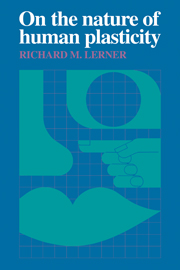Book contents
- Frontmatter
- Contents
- Foreword by Paul Baltes
- Preface
- 1 Perspectives on plasticity
- 2 The life-span view of human development: philosophical, historical, and substantive bases
- 3 Gene marking, recombinant DNA technology, and gene transfer: toward true gene therapy
- 4 Neuroanatomical bases of human plasticity
- 5 Human neurochemistry and the role of neurotransmitters
- 6 Evolutionary biology and hominid evolution
- 7 Comparative-developmental psychological bases of plasticity
- 8 Individual and group interdependencies
- 9 Toward future multidisciplinary efforts
- 10 Conclusions: On the limits of plasticity and the plasticity of limits
- References
- Author index
- Subject index
10 - Conclusions: On the limits of plasticity and the plasticity of limits
Published online by Cambridge University Press: 22 March 2010
- Frontmatter
- Contents
- Foreword by Paul Baltes
- Preface
- 1 Perspectives on plasticity
- 2 The life-span view of human development: philosophical, historical, and substantive bases
- 3 Gene marking, recombinant DNA technology, and gene transfer: toward true gene therapy
- 4 Neuroanatomical bases of human plasticity
- 5 Human neurochemistry and the role of neurotransmitters
- 6 Evolutionary biology and hominid evolution
- 7 Comparative-developmental psychological bases of plasticity
- 8 Individual and group interdependencies
- 9 Toward future multidisciplinary efforts
- 10 Conclusions: On the limits of plasticity and the plasticity of limits
- References
- Author index
- Subject index
Summary
The preceding chapters have, in my view, indicated that there is plasticity at each of the levels of analysis I have considered. Often, this plasticity derives from processes at one level of analysis influencing and being influenced by other levels' processes. Thus, key processes at any level may be appropriate targets of intervention as a consequence of this plasticity. And because of embeddedness of one level in another, one can modify processes at one level (e.g., cognitive–behavioral ones) to reach a target at another (e.g., those pertinent to neurotransmitters). Such reciprocity provides a compelling rationale of interdisciplinary research and intervention.
Accordingly, there is reason to be optimistic that in the future lie further paths to understanding how to better actualize humans' potential plasticity. But this optimism must be tempered by the recognition that along these paths lie two problematic sets of issues: First, throughout this book I have reviewed evidence that the organism's “reservoir” of plasticity decreases across life; that is, while plasticity is ubiquitous across life, the domains or band within which plasticity may be evidenced or actualized decrease. Second, there are several theoretical, substantive, and technological problems that must be resolved in order to further the ability of science to enhance human plasticity. These two sets of issues constitute significant limitations on both plasticity per se and knowledge about it. Let us treat each issue separately.
Plasticity as an ever-present but declining phenomenon
An organism's plasticity does not remain at a constant level across its life span.
- Type
- Chapter
- Information
- On the Nature of Human Plasticity , pp. 163 - 174Publisher: Cambridge University PressPrint publication year: 1984



